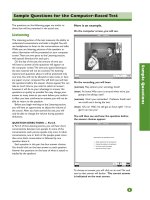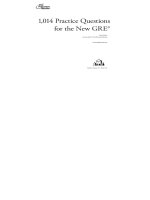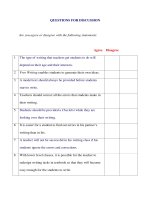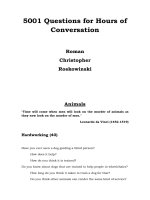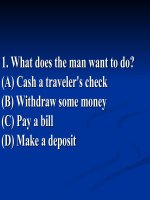Questions for chapter 3
Bạn đang xem bản rút gọn của tài liệu. Xem và tải ngay bản đầy đủ của tài liệu tại đây (41.33 KB, 5 trang )
Questions for Chapter 3
1.
Why do companies have quality assurance programs?
Because no manufacturer produces perfect products all the time. Even so,
quality is a key issue, and customer satisfaction is essential to successful
business. Companies have quality assurance programs to ensure that customers
get what they pay for/to ensure customer satisfaction
2.
Why may conflicts arise in negotiating specifications?
Because negotiation of specifications can be a difficult process. For the
manufacturer, the temptation is to be over-optimistic and to agree with
impossible specifications-few things in business life are riskier. Conflicts often
arise within the exporter's own team: the marketing manager is eager to sell
brilliant products, but the production department knows that it cannot make
them.
3.
What is the benefit of a well-designed set of specifications?
A well-designed set of specifications protects both sides: the seller and the
buyer. The buyer is protected against inferior products as it can reject any
equipment that fails to meet specification. The seller can protect its reputation
and avoid cost as the buyer will be unable to find any excuses for rejection or
for exaggerated defects liability claims.
4.
Which kind of goods needs pre- delivery inspection? Give example.
It depends on the importer's policy. Sophisticated items or capital equipment
can be inspected before shipment.
5.
What are the functions of independent inspection?
It reports on the weight, the size, and most important - the value of the goods.
This inspection prevents exporter and buyer agreeing an unrealistically low
invoice price in order to avoid customs duties in the buyer's country and
shipment of patently defective goods.
6.
What does customs inspection reveal?
Customs inspection will reveal discrepancies in weight, size and description.
7.
What is the real inspection for goods?
The real inspection for goods means the buyer will open package to inspect the
goods when it arrives.
8.
Name quality checks on goods exported for resale
Quality checks on goods exported for resale:
1. Inspection by buyer during manufacture
2. Inspection buy buyer or buyer's agent before delivery
3. Inspect by inspection service (e.g. SGS)
4. Inspection by carrier on dispatch
5. Open package inspection on arrival at destination
6. Seller's liability for defects after sale
9.
How long is the defect liability period?
The defect liability period is negotiable, it is likely to be several months from the date
of delivery, or the date of arrival.
10.
What are 5 steps in negotiating the Defects Liability Period?
5 steps in negotiating the defects liability period:
Step 1: Inspection: When are the goods inspected? And when can the buyer reject
them?
Step 2: Terms: Warranty or guarantee
Step 3: Definition: What is and what is not a defect?
Step 4: Timing: How long is the defects liability period? When does it begin? And
what about other timings?
Step 5: Corrective action: What must the seller do to cure defects?
11.
What counts as a patent defect? Give examples.
Defects that are apparent, e.g., wrong items, broken or missing parts, scratches,
and so on.
12.
What counts as a latent defect? Give examples.
The defects that come to light after buyer's acceptance, or hidden, e.g., structure
weakness, failure to operate at high/low temperature, high fuel consumption.
13.
What are Implied Warranties?
Under most laws, a buyer can make certain assumptions about goods even if the
exporter gives no express warranty. Lawyers call these assumptions "implied
warranties".
14.
What are 3 types of Implied Warranties? Give examples
3 types of implied warranties:
1. Implied warranty of conformity with contract: In principle, major
discrepancies allow the buyer the right to reject the goods and cancel the
contract; minor discrepancies do not.
2. Implied warranty of merchantable quality: The buyer has the right to reject
goods and cancel the contract if they are not of merchantable quality: The buyer
has the right to reject unusable items if they fail to work in particular machine
and if the exporter knew the buyer's intended purpose; and if the buyer trusted
the exporter to supply correct goods.
3. Implied Warranty of fitness for intended purpose. If the Exporter knew the
intended purpose, and if the Buyer relied on the Exporter's judgment, the Buyer
can reject the goods that are not suitable for their intended purposes.
15.
What is a Product Warranty?
A promise by the exporter to cure defects in his products. There are two parties:
the seller and the buyer
16.
What is a Product Guarantee?
A promise of the guarantor to pay the beneficiary, made out at the request of the
principle. There are three parties: the guarantor, the principle and the
beneficiary.
17.
What are the similarities and differences between a guarantee and a
warranty?
Similarities: Both are promise about performance, payment is only made when
there is non-performance of products or of parties involved.
Differencies:
Guarantee:
Contract to perform the promise or discharge the liability
Trilateral: guarantor, principle, and beneficiary
Promise about somebody else's performance
- To obtain loan
- Credit purchase/sales
- For good conduct or honesty of person
Warranty:
State of the subject of contract
Bilateral: the seller and the buyer
Commitment of seller to make good defects of product or services in a
fixed period.
- To enhance their value
- Show of quality
- Assurance of product performance
18.
What are the 3 types of defects? Give examples.
- Defective workmanship: a product with defective workmanship is incorrectively
built
Ex: a radio lacks the wires connecting the loudspeaker to the amplifier, nuts and
bolts are inadequately tightened.
- Defective materials: defective materials are materials or parts of a product that are
inferior or somehow incorrect.
Ex: tractor wheels that should be galvanize are simply painted with anti-rust paint,
a drive belt made or inferior rubber falls to pieces after five hours use.
- Defective design: defective design means that a product does not meet
specifications.
Ex: a crane on an oilrig vibrates dangerously in high wind, a voltmeter that is
specified as accurate within 1 millivolt is accurate within only 5 millivolts.
19.
What are the common exclusions of defects? Give example.
- Fair wear and tear: the results of normal use
Ex: the plastic handle on an electric drill is scratched and scuffed after 6 months
use.
- Misuse: seriously incorrect handling by the buyer
Ex: the use of acetone to clean plastic components, failure to check the oil level
in a motor.
20.
What is the Defect Liability Period?
The period during which the exporter is liable for and must make good defects
that are apparent on delivery or that come to light later.
21.
What are the four timing decisions in Defect Liability Period?
-The starting point of the period (defect liability period)
- The time allowed to the buyer to notify the exporter of a defect (notification
period)
- The time the exporter has to correct the defect (rectification period)
- The period during which the buyer can begin a legal action (legal action
period)
22.
What is “Eternal warranty”? How to avoid problems of an Eternal
warranty?
External warranty is an endlessly renewed liability for defects. The exporter
cannot break the chain of warranty and is involved in endless responsibility for
the goods. The problems can be avoided with a cut-off clause such as: the total
warranty period shall in no case exceed 3 years.
23.
What are the 5 options for curing defects?
-Repair
- Allow the buyer to repair at exporter's cost
- Replace (part or whole item)
- Reduce the price
- Return the goods and refund the price
24.
Which corrective method is least favorable for the seller? Why?
Returning the goods and refunding the price seems to be the least favorable for
the exporter because this can be considered a cancellation of the contract. Often
defective goods are not worth the cost of return shipment to the exporter's
country. That means the deal is a total loss for the exporter.
